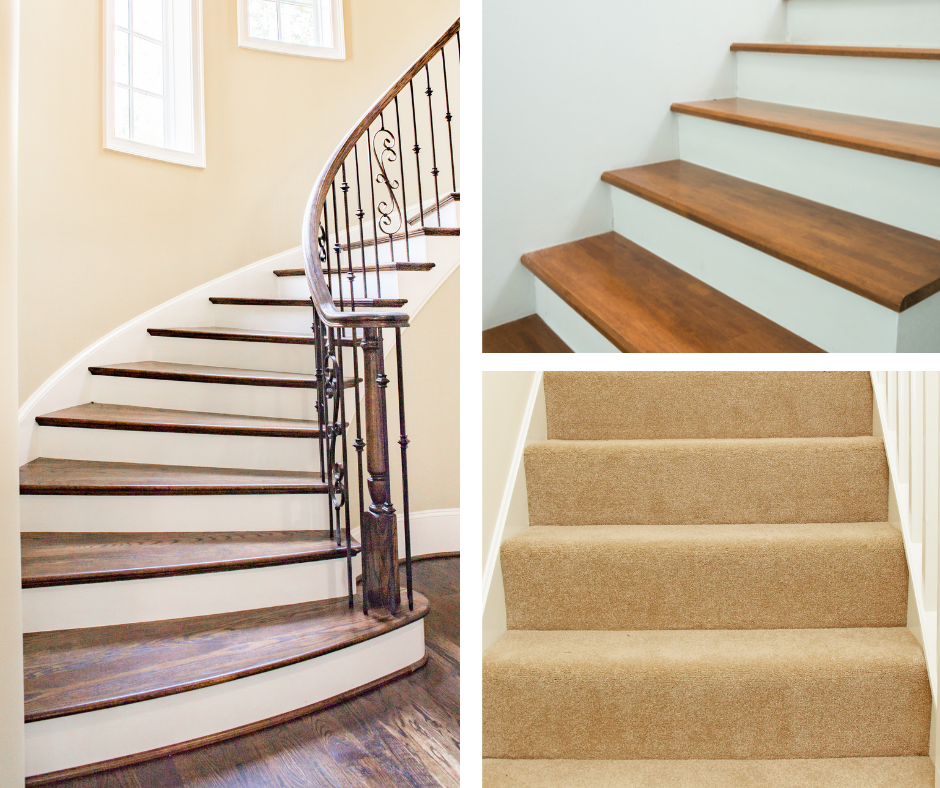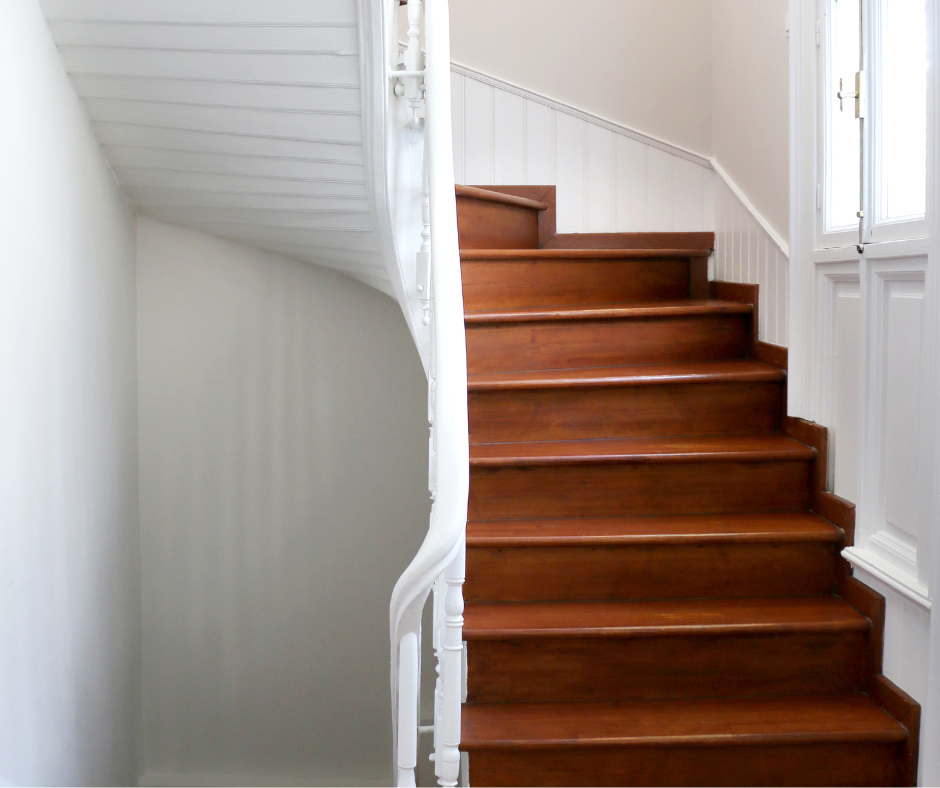Slippery stairs and frayed carpet edges are more than just an eyesore—they’re a safety risk.
Rubber stair nosing for carpet adds a non-slip surface, protects carpet edges from wear, and extends the life of your stairs.
Whether in a home or business, it provides an affordable and effective way to enhance durability and safety.
In this guide, you’ll learn how rubber stair nosing works, its benefits, the best installation methods, and how to choose the right option for your needs, including considering the added comfort and safety of carpet stair treads.
Keep reading to make your stairs safer, longer-lasting, and visually appealing.
Benefits of Rubber Stair Nosing for Carpet
Rubber stair nosing offers several key advantages for carpeted stairs:
Safety
A non-slip surface reduces the risk of falls inside and outside the home.
It provides additional traction in wet or humid environments, making it ideal for homes with outdoor stairways or basements.
A well-designed stair nosing can also create better visibility, reducing missteps in low-light conditions.
Durability
It protects carpet edges from fraying, helping them last longer.
Heavy foot traffic can wear out carpet edges quickly, but rubber nosing absorbs impact and keeps carpet fibers intact.
It also prevents buckling and lifting, which can be a tripping hazard if left unprotected.
Aesthetics
It gives your staircase a clean, polished, and professional look.
Rubber nosing is available in various colors and finishes, allowing you to match it to your home or business décor.
It also creates a seamless transition between steps, making the entire staircase look more cohesive.
Rubber nosing can also be used on concrete and other surfaces for extra protection.
When paired with other materials like vinyl or metal, rubber nosing can enhance both function and style.
What Are the Different Types of Stair Nosing?
Different types of stair nosing are designed for various needs:
-
Metal Stair Nosing: Best for high-traffic areas like offices and commercial spaces due to its strength. Aluminum and stainless steel options provide maximum durability, resisting dents, scratches, and moisture damage. Metal nosing is often used in industrial or commercial settings where heavy-duty protection is required.
-
Vinyl Stair Nosing: A budget-friendly option that’s easy to install and works well for residential homes. It is lightweight and available in multiple colors, making it a good choice for homeowners on a budget. Vinyl nosing is also flexible, making it easier to fit around curved stair edges.
-
Rubber Stair Nosing: Flexible and slip-resistant, making it a great choice for both homes and businesses. Rubber’s natural flexibility allows it to fit snugly over various stair materials, including wood, tile, and carpet. Its water-resistant properties also make it a great choice for outdoor stairways or high-moisture areas.
Selecting the Right Stair Nosing
The best stair nosing depends on your staircase needs.
For carpeted stairs, rubber nosing is the top choice.
It is flexible, slip-resistant, and easy to install compared to other materials.
When selecting stair nosing, consider traffic volume, environmental conditions, and design preferences.
If your stairs are in a high-moisture area, choose rubber or vinyl over metal, which may become slippery when wet.
For commercial buildings, selecting a durable, code-compliant option is essential to meet safety regulations.
Installation Process of Rubber Stair Nosing
Installing rubber stair nosing is a quick and easy process that only requires basic tools.
Proper installation ensures maximum safety and longevity, preventing peeling or movement over time.
By following each step carefully, you can create a secure, long-lasting stair solution.
Here’s how to do it:
Step 1: Prepare the Surface
Clean the stairs and make sure they are completely dry.
Any dust or debris left behind can weaken the adhesive and cause the nosing to come loose over time.
For outdoor staircases, check for moisture buildup before starting the installation.
Step 2: Measure and Cut
Measure each step and cut the rubber nosing to fit.
Use a sharp utility knife or heavy-duty shears to ensure a precise, even cut.
If your stairs have rounded edges, use a heat gun to slightly soften the rubber for a better fit.
Step 3: Apply Adhesive
Spread a strong construction adhesive evenly on the nosing.
Make sure to apply the adhesive all the way to the edges to prevent lifting or peeling.
For extra security, consider adding screws or nails in high-traffic areas.
Step 4: Press into Place
Firmly press the nosing onto the stair edge to create a tight bond.
Hold it in place for at least a minute to allow the adhesive to grip properly.
Apply even pressure across the nosing to ensure it sticks securely.
Step 5: Secure the Nosing
Use a roller to remove air bubbles and make sure the nosing sticks properly.
A rubber mallet can also help press down the nosing for a stronger, long-lasting hold.
If necessary, wipe away any excess adhesive before it dries
Exterior Stair Nosing
Outdoor stairs face constant exposure to rain, snow, and temperature changes, making them more prone to wear and safety hazards.
Exterior stair nosing provides a non-slip surface, improves visibility, and protects stair edges from deterioration.
Whether for residential patios, decks, or commercial walkways, adding the right stair nosing enhances both safety and longevity.
The best exterior stair nosing materials are rubber, aluminum, and composite options, as they resist moisture, UV damage, and extreme temperatures.
Many exterior stair nosings also include grit surfaces or textured finishes for extra traction, reducing the risk of slipping in wet conditions.
Proper installation is key for durability and effectiveness.
Using waterproof adhesives, screws, or expansion anchors ensures a secure fit, even in high-traffic areas.
Regular maintenance, such as cleaning dirt buildup and checking for loose edges, will help keep your exterior stair nosing in top condition.
Exterior Stair Nosings for Concrete
Concrete stairs, whether in commercial buildings, public spaces, or residential patios, can become slippery and unsafe over time.
Exterior stair nosings for concrete add an essential layer of protection, preventing accidents and extending the lifespan of stair edges.
Aluminum and rubber stair nosings are popular choices for concrete stairs.
Aluminum nosing offers a durable, long-lasting solution with built-in traction grooves, while rubber nosing provides flexibility and slip resistance in wet conditions.
Some options include high-visibility edges to improve safety in low-light areas.
Installing stair nosing on concrete requires strong adhesives, mechanical fasteners, or embedded installation methods to ensure it stays in place.
Regular inspections and occasional resealing will help maintain its performance, especially in harsh weather environments.
By choosing the right exterior stair nosing for concrete, you can prevent wear, enhance safety, and keep outdoor steps looking professional and well-maintained for years to come.
Stepping It Up
Rubber stair nosing for carpet is a smart upgrade for any home or business.
It provides essential safety benefits, protects your carpet, and enhances the overall appearance of your stairs.
With the right installation and maintenance, rubber nosing can extend the life of your staircase and reduce long-term costs.
By choosing the right nosing, following proper installation steps, and maintaining it correctly, your stairs will stay secure and stylish for years to come.
Upgrade Your Stairs with Style, Safety, and Durability
At Oak Valley Designs, we know that the right stair solution isn’t just about looks—it’s about safety, durability, and comfort.
Whether you need carpet stair treads, stair landings, or hallway runners, we’re here to help you create a polished, professional design that enhances your home.
Our high-quality products are designed to protect your stairs, reduce wear, and add a touch of elegance to your space.
If you’re ready to upgrade your staircase with a solution that fits your style and needs, let’s talk.
Visit our website, give us a call, or send us an email—we’re happy to answer any questions and help you find the perfect fit for your home.
-
Website: https://oakvalleydesigns.com/
-
Phone: 706.331.0315
-
Email: info@oakvalleydesigns.com
-
Address: 30 River Ct SW Bldg E, Cartersville, GA 30120




